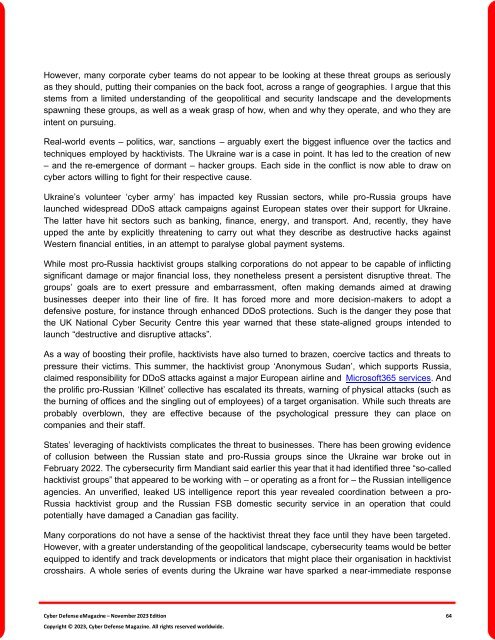The Cyber Defense eMagazine November Edition for 2023
Cyber Defense eMagazine November Edition for 2023 #CDM #CYBERDEFENSEMAG @CyberDefenseMag by @Miliefsky a world-renowned cyber security expert and the Publisher of Cyber Defense Magazine as part of the Cyber Defense Media Group as well as Yan Ross, Editor-in-Chief and many more writers, partners and supporters who make this an awesome publication! 196 page November Edition fully packed with some of our best content. Thank you all and to our readers! OSINT ROCKS! #CDM #CDMG #OSINT #CYBERSECURITY #INFOSEC #BEST #PRACTICES #TIPS #TECHNIQUES
Cyber Defense eMagazine November Edition for 2023 #CDM #CYBERDEFENSEMAG @CyberDefenseMag by @Miliefsky a world-renowned cyber security expert and the Publisher of Cyber Defense Magazine as part of the Cyber Defense Media Group as well as Yan Ross, Editor-in-Chief and many more writers, partners and supporters who make this an awesome publication! 196 page November Edition fully packed with some of our best content. Thank you all and to our readers! OSINT ROCKS! #CDM #CDMG #OSINT #CYBERSECURITY #INFOSEC #BEST #PRACTICES #TIPS #TECHNIQUES
Create successful ePaper yourself
Turn your PDF publications into a flip-book with our unique Google optimized e-Paper software.
However, many corporate cyber teams do not appear to be looking at these threat groups as seriously<br />
as they should, putting their companies on the back foot, across a range of geographies. I argue that this<br />
stems from a limited understanding of the geopolitical and security landscape and the developments<br />
spawning these groups, as well as a weak grasp of how, when and why they operate, and who they are<br />
intent on pursuing.<br />
Real-world events – politics, war, sanctions – arguably exert the biggest influence over the tactics and<br />
techniques employed by hacktivists. <strong>The</strong> Ukraine war is a case in point. It has led to the creation of new<br />
– and the re-emergence of dormant – hacker groups. Each side in the conflict is now able to draw on<br />
cyber actors willing to fight <strong>for</strong> their respective cause.<br />
Ukraine’s volunteer ‘cyber army’ has impacted key Russian sectors, while pro-Russia groups have<br />
launched widespread DDoS attack campaigns against European states over their support <strong>for</strong> Ukraine.<br />
<strong>The</strong> latter have hit sectors such as banking, finance, energy, and transport. And, recently, they have<br />
upped the ante by explicitly threatening to carry out what they describe as destructive hacks against<br />
Western financial entities, in an attempt to paralyse global payment systems.<br />
While most pro-Russia hacktivist groups stalking corporations do not appear to be capable of inflicting<br />
significant damage or major financial loss, they nonetheless present a persistent disruptive threat. <strong>The</strong><br />
groups’ goals are to exert pressure and embarrassment, often making demands aimed at drawing<br />
businesses deeper into their line of fire. It has <strong>for</strong>ced more and more decision-makers to adopt a<br />
defensive posture, <strong>for</strong> instance through enhanced DDoS protections. Such is the danger they pose that<br />
the UK National <strong>Cyber</strong> Security Centre this year warned that these state-aligned groups intended to<br />
launch “destructive and disruptive attacks”.<br />
As a way of boosting their profile, hacktivists have also turned to brazen, coercive tactics and threats to<br />
pressure their victims. This summer, the hacktivist group ‘Anonymous Sudan’, which supports Russia,<br />
claimed responsibility <strong>for</strong> DDoS attacks against a major European airline and Microsoft365 services. And<br />
the prolific pro-Russian ‘Killnet’ collective has escalated its threats, warning of physical attacks (such as<br />
the burning of offices and the singling out of employees) of a target organisation. While such threats are<br />
probably overblown, they are effective because of the psychological pressure they can place on<br />
companies and their staff.<br />
States’ leveraging of hacktivists complicates the threat to businesses. <strong>The</strong>re has been growing evidence<br />
of collusion between the Russian state and pro-Russia groups since the Ukraine war broke out in<br />
February 2022. <strong>The</strong> cybersecurity firm Mandiant said earlier this year that it had identified three “so-called<br />
hacktivist groups” that appeared to be working with – or operating as a front <strong>for</strong> – the Russian intelligence<br />
agencies. An unverified, leaked US intelligence report this year revealed coordination between a pro-<br />
Russia hacktivist group and the Russian FSB domestic security service in an operation that could<br />
potentially have damaged a Canadian gas facility.<br />
Many corporations do not have a sense of the hacktivist threat they face until they have been targeted.<br />
However, with a greater understanding of the geopolitical landscape, cybersecurity teams would be better<br />
equipped to identify and track developments or indicators that might place their organisation in hacktivist<br />
crosshairs. A whole series of events during the Ukraine war have sparked a near-immediate response<br />
<strong>Cyber</strong> <strong>Defense</strong> <strong>eMagazine</strong> – <strong>November</strong> <strong>2023</strong> <strong>Edition</strong> 64<br />
Copyright © <strong>2023</strong>, <strong>Cyber</strong> <strong>Defense</strong> Magazine. All rights reserved worldwide.

















